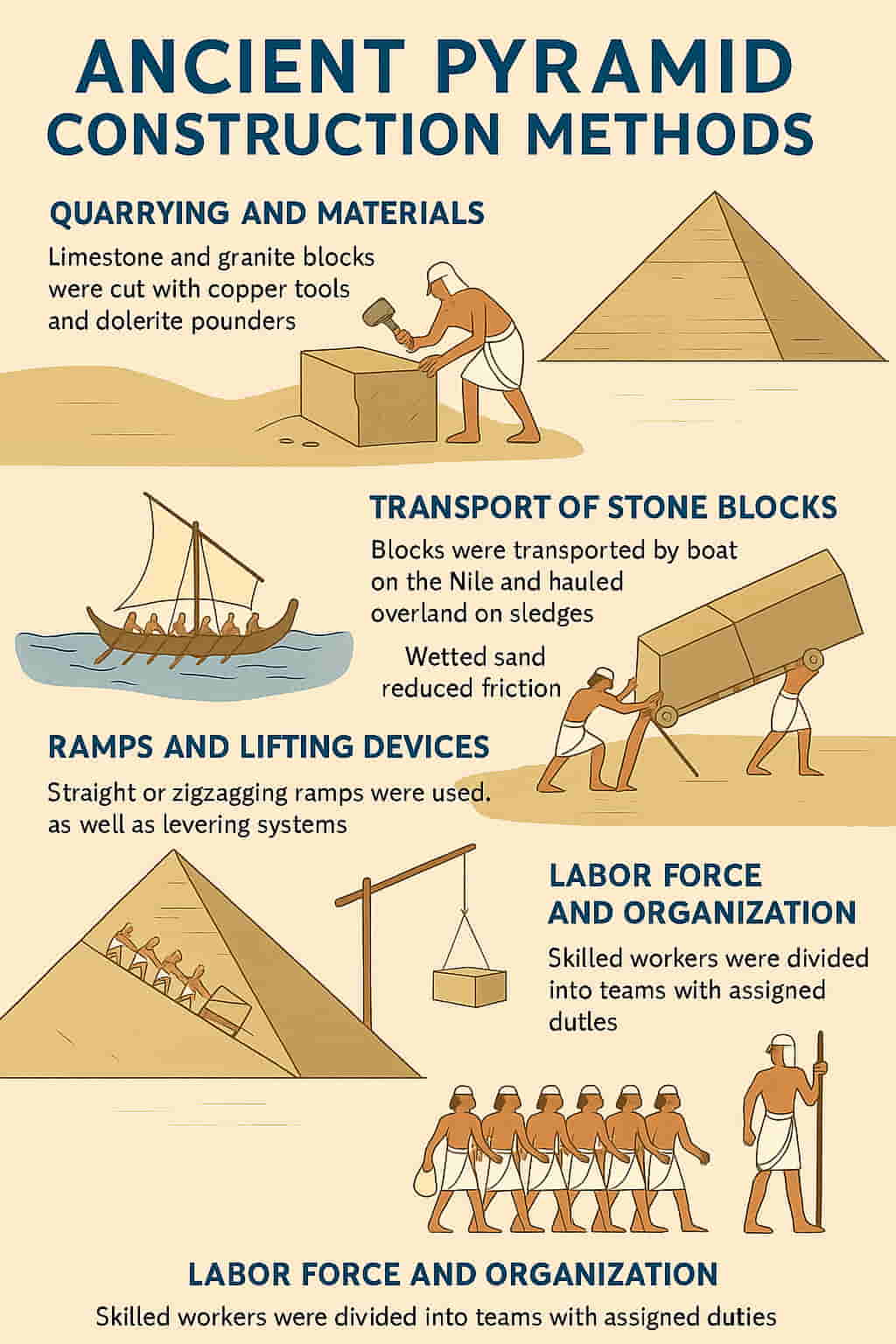
The Egyptian pyramids stand as the most iconic structures of the ancient world, inspiring awe and mystery even after thousands of years. What makes them even more astonishing is that no comprehensive manual or record exists to explain precisely how they were constructed. As modern researchers continue to investigate the ancient pyramid construction methods, it becomes increasingly clear that these monuments were not the result of alien intervention or lost technology, but rather the product of brilliant planning, ingenious engineering, and tireless human effort. This article explores the real strategies the ancient Egyptians used to build their pyramids—revealing a story as impressive as the monuments themselves.
Why No Official Records Exist
Despite their detailed hieroglyphics and religious texts, Egyptians left no comprehensive documentation of how their pyramids were built. The lack of formal records has led to wild speculation, but historians believe the answer is simple: the methods were likely passed down orally and considered too practical or routine to merit inscription.
As Smithsonian Magazine explains, written records emphasized spiritual significance over mundane logistics. Religious texts and royal decrees dominated formal inscriptions, while daily construction practices remained part of an oral tradition shared among labor crews and architects.
The Foundation: Stone, Sand, and Science
Quarrying: Turning Earth into Eternity
Most pyramid stones were quarried locally, with softer limestone used for the core and polished Tura limestone for the outer casing. The hard granite used in chambers like the King’s Chamber was brought from Aswan, over 500 miles away. These materials were cut using tools such as copper chisels and dolerite pounders—methods replicated in experiments conducted by teams like those at MIT.
Transport: Engineering with Water and Sand
Once quarried, stones were hauled across the desert on wooden sledges. A 2014 study published by PNAS shows that Egyptians moistened the sand to reduce friction by up to 50%, making the heavy loads manageable for organized teams. Stones were then floated down the Nile on barges, as supported by the discovery of the “Diary of Merer”—an ancient journal found near the Red Sea that detailed how limestone was delivered to Giza.
National Geographic confirms that the Nile River played a vital role in pyramid logistics, acting as a natural highway for transporting materials from distant quarries.
Ramping the Impossible: The Logistics of Elevation
Theories That Explain the Ascent
Constructing a structure 480 feet tall with stone blocks required incredible ingenuity. Among the theories developed by modern researchers:
-
Straight Ramps: These would have needed to be longer than the pyramid itself, using millions of extra tons of material.
-
Zig-Zag Ramps: These side-winding ramps may have allowed easier vertical transport without overly steep inclines.
-
Internal Spiral Ramps: Jean-Pierre Houdin’s theory, endorsed by several engineers, proposes a spiral tunnel inside the pyramid’s outer shell—supported by thermal scans revealing unexplained voids.
History Channel details how each theory attempts to explain the same challenge: lifting massive stones hundreds of feet into the air using only human power and basic tools.
The Workforce: Skilled, Respected, and Organized
Contrary to Hollywood portrayals, slaves did not build the pyramids. According to archaeological findings and reports from institutions like Harvard University’s Giza Project, the laborers were skilled workers who lived in nearby villages with access to food, healthcare, and a structured workday.
Villages unearthed near Giza reveal bakeries, breweries, and even medical facilities. These builders worked in crews, proudly naming themselves with titles such as “Friends of Khufu” and inscribing graffiti in hidden chambers. The workforce was organized with military precision, reflecting a high degree of logistical planning and resource coordination.

Tools, Geometry, and Cosmic Order
Engineering Tools That Stood the Test of Time
Egyptians used plumb bobs, copper saws, leveling instruments, and ropes to shape and place each stone. Their understanding of geometry allowed them to level the base of the Great Pyramid within a centimeter of perfection.
According to NASA Earth Observatory, the pyramid’s alignment with the cardinal directions is nearly perfect—pointing to their use of celestial tools and star observations to orient the structure.
Geometry as Sacred Science
The dimensions of the Great Pyramid reflect sacred mathematics. Its slope approximates the golden ratio (1.618), and its sides face true north, south, east, and west with almost impossible precision. These dimensions may have symbolized divine harmony, reinforcing the pharaoh’s connection to the gods.
Material Mastery: Mortar, Ventilation, and Stone Casting
Unmatched Mortar Technology
The gypsum-based mortar used between stones has survived for over 4,500 years, even though modern chemists have struggled to replicate it. Its purpose wasn’t structural but to absorb shock, prevent shifting, and maintain level alignment. Live Science has published detailed investigations into this composition, confirming its unique properties.
Innovative Ventilation
The King’s Chamber contains two narrow shafts leading to the pyramid’s surface. Originally thought to be ceremonial, modern robotics—like those developed at Leeds University—have explored these shafts and discovered sealed doors with copper handles, suggesting an engineering rather than symbolic purpose.
H2: Why Ancient Pyramid Construction Methods Continue to Fascinate
The scale and precision of ancient pyramid construction methods reflect not only engineering genius but also the unshakable belief system of ancient Egyptians. These methods were embedded in religious ritual, social organization, and even cosmic alignment. Today, researchers from the University of Chicago and other institutions study these methods not just to understand the past—but to apply ancient wisdom to modern challenges like large-scale logistics, sustainability, and energy-efficient construction.
Rediscovering Ancient Innovation
In recent years, ground-penetrating radar, 3D scanning, and satellite imaging have revolutionized pyramid research. The ScanPyramids project has discovered enormous voids inside the Great Pyramid—possibly hidden chambers or storage corridors. Meanwhile, researchers from Cairo University and international teams have uncovered lost river channels near Giza that likely facilitated barge access directly to the construction site.
As more technology is applied to ancient ruins, it becomes clear that Egyptian builders were not only spiritual visionaries but pragmatic engineers who understood material science, hydrology, and logistics in ways that still inspire awe.
FAQ: Ancient Pyramid Construction Methods
Q1: How many people worked on the pyramids?
Estimates range from 20,000 to 40,000 skilled laborers working in rotating shifts over 20 years, according to Harvard’s Giza Project.
Q2: Why didn’t they use wheels?
The desert terrain was too soft for wheeled carts. Wooden sleds dragged over wet sand proved far more efficient.
Q3: What was the purpose of the ventilation shafts?
They may have provided airflow or celestial alignment, particularly pointing to stars associated with rebirth in Egyptian mythology.
Q4: Are there still undiscovered rooms in the pyramids?
Yes. Recent scans suggest hidden chambers exist within the Great Pyramid, potentially linked to its original construction strategy or burial rituals.
Q5: Were the pyramid builders paid?
Yes. Workers were provided with food, beer, and clothing. Many were skilled artisans and craftsmen, not slaves.




